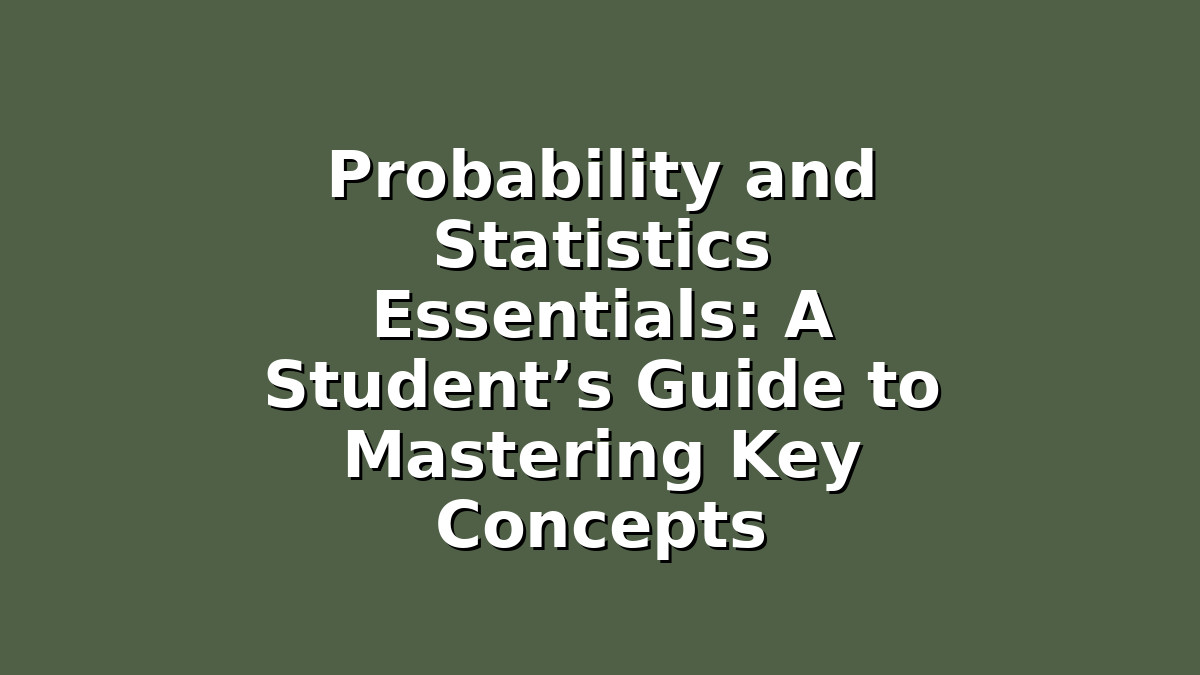Preparing for exams in probability and statistics can feel overwhelming, especially if these topics seem abstract or math-heavy. However, with the right approach and study strategies, you can confidently grasp the essential concepts and perform well on your tests. This comprehensive guide is designed to help students like you understand the fundamentals of probability and statistics, apply effective study techniques, and develop a strong foundation for success.
Introduction
Probability and statistics play a crucial role not only in academics but also in everyday decision-making, science, business, and technology. Whether you’re tackling probability problems, interpreting data sets, or working on inferential statistics, mastering these subjects can open doors to numerous fields. The key is to break down complex ideas into manageable parts and practice consistently. In this article, we’ll explore the core topics you need to know, share actionable study tips, and encourage you to approach these subjects with confidence.
—
1. Understanding Core Concepts: Build a Strong Foundation
Before diving into problem-solving, it’s essential to understand the fundamental concepts of probability and statistics.
Probability Essentials:
– Basic Terminology: Get comfortable with terms like *experiment*, *outcome*, *event*, and *sample space*. For example, rolling a die is an experiment, and getting a 4 is an outcome.
– Probability Rules: Learn the probability range (from 0 to 1), the addition rule (for mutually exclusive events), and the multiplication rule (for independent events).
– Types of Probability: Understand theoretical probability (based on known possible outcomes), experimental probability (based on actual experiments), and subjective probability (personal judgment).
Statistics Essentials:
– Descriptive Statistics: Focus on measures such as mean, median, mode, range, variance, and standard deviation. These describe and summarize data sets.
– Data Types: Recognize different data types—qualitative (categorical) vs. quantitative (numerical)—and their roles in analysis.
– Distributions: Get familiar with common distributions like normal distribution and uniform distribution, which describe how data values are spread.
Study Tip: Create flashcards with key terms and formulas. Reviewing these regularly will reinforce your understanding and boost recall during exams.
—
2. Practical Problem-Solving: Practice with Purpose
Working through problems is the best way to internalize probability and statistics concepts.
Approach to Practice:
– Start Simple: Begin with basic problems that focus on applying single concepts, such as calculating the probability of a single event.
– Step-by-Step Solutions: Write down each step clearly. For example, when evaluating combined events, break down the problem by identifying whether the events are independent or mutually exclusive.
– Use Real-Life Examples: Apply problems to real-world scenarios—like predicting weather outcomes or analyzing sports statistics—to make the concepts more relatable.
– Work On Past Papers: If you have access to previous exams or sample questions, use them to familiarize yourself with the question formats and time constraints.
Study Tip: Set aside daily or weekly time blocks dedicated specifically to solving problems. Consistent practice helps build confidence and uncovers areas where you need further review.
—
3. Interpreting Data and Statistical Results: Think Critically
Statistics is not just about numbers—it’s about making sense of data and drawing meaningful conclusions.
Key Skills in Data Interpretation:
– Reading Graphs and Tables: Learn to interpret bar charts, histograms, scatter plots, and pie charts. Identify trends, outliers, and patterns that inform statistical analysis.
– Understanding Statistical Significance: Get familiar with concepts like p-values and confidence intervals, which help determine whether results are meaningful or due to chance.
– Distinguishing Correlation vs. Causation: Recognize that correlation between variables does not imply one causes the other.
– Writing Clear Explanations: When answering exam questions, explain your reasoning clearly. Describe the implications of the data, not just compute values.
Study Tip: Practice summarizing data findings in your own words. Try explaining key results to a friend or family member, which can improve your ability to communicate complex ideas clearly.
—
Conclusion
Mastering probability and statistics is achievable with structured learning and consistent practice. Focus on understanding the core concepts first, then build your skills by solving a variety of problems, and finally, hone your ability to interpret and explain statistical data. Remember, these subjects reward curiosity and persistence. Don’t hesitate to ask for help when needed and use supplementary resources like online tutorials, study groups, or tutoring.
With steady effort and the right mindset, you’ll find probability and statistics not only manageable but also rewarding. Good luck with your studies and exams—you’ve got this!
—

Responses